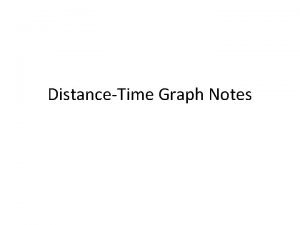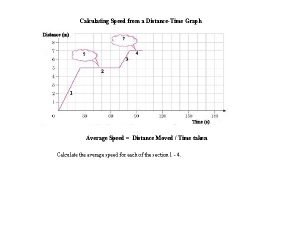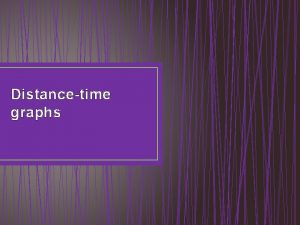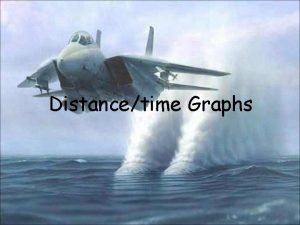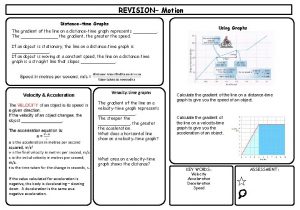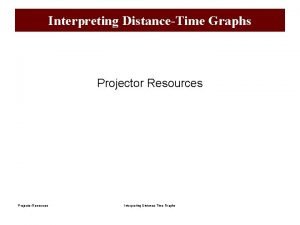REVISION Motion Distancetime Graphs Using Graphs The gradient





- Slides: 5

REVISION– Motion Distance-time Graphs Using Graphs The gradient of the line on a distance-time graph represents _____. The _______ the gradient, the greater the speed. If an object is stationary, the line on a distance-time graph is _______. If an object is moving at a constant speed, the line on a distance-time graph is a straight line that slopes _______. Velocity & Acceleration Velocity-time graphs The gradient of the line on a velocity-time graph represents _______. The steeper the ______, the greater the acceleration. What does a horizontal line show on a velocity-time graph? What area on a velocity-time graph shows the distance? If the value calculated for acceleration is negative, the body is decelerating – slowing down. A deceleration is the same as a negative acceleration. Calculate the gradient of the line on a distance-time graph to give you the speed of an object. Calculate the gradient of the line on a velocity-time graph to give you the acceleration of an object. KEY WORDS: Velocity Acceleration Deceleration Speed ASSESSMENT:

REVISION– Forces between objects. The resultant force is a single force that has the same effect as all the forces acting on an object. Forces are measured in newtons, N. What is the rule with regard to forces? On the Road Resultant Force If an object is accelerating there must be a resultant force acting on it. If an object is accelerating what 3 things can it be doing? If a vehicle is travelling at a steady speed, the resultant force on it is _____. The driving forces are equal and opposite to the frictional forces. Stopping distance Distance travelled during the thinking distance, plus the distance it travels under the braking distance Thinking distance Is increased if the driver is tired or under the influence of _______ or _____. Force and Acceleration What always causes an acceleration? The bigger the resultant force on an object, the greater its __________. Braking distance F=mxa F is the resultant force in newtons, N. m is the mass in kilograms, kg a is the acceleration in m/s² Acceleration is a change in velocity. An object can accelerate by changing its ________ even if it is going at a _______. Therefore a __________ is needed to make an object change _________. Can be increased by: Poorly maintained roads Bad weather conditions. Condition of the car: eg: Worn ____________ Reaction time depends on the ______. Braking distance depends on the ______, _____________ and the condition of the vehicle. KEY WORDS: Force Newton Mass ASSESSMENT:

REVISION – Forces continued. Falling Objects The force of gravity is called ______ An object acted on only by gravity will accelerate at about ______. F=mxa Where: F is the resultant force in newtons, N. m is the mass in kilograms, kg a is the acceleration in m/s² Becomes: W=mxg Where: W is the weight in newtons, N m is the mass in kilograms, kg g is the acceleration due to gravity in m/s² If an object falls through a fluid the fluid exerts a _____ force on the object. Faster the object falls, the bigger the drag force becomes until it becomes equal to the weight of the object. Resultant force will then be ______. This is called ________. DON’T FORGET: Mass is the amount of matter in an object. Weight is the force of gravity acting on it. Stretching & Squashing What does elastic mean? Force and Speed Issues Reduces the speed of a vehicle reduces the amount of what? What is this called? The extension of a spring is DIRECTLY PROPORTIONAL to the force applied to it, provided the limit of proportionality is not exceeded. How do we know that it is directly proportional? Reducing air resistance, making a vehicle more _________ also improves fuel economy. Speed cameras are used to discourage motorists from doing what? In pairs they can be used to calculate _________ speed. What happens if you are caught speeding? When does skidding happen? Extension is the difference between the length of the spring and its ______. Hooke’s Law Equation: F = k x e Where F is the force applied in newtons, N k is the spring constant of the spring in newtons per metre, N/m e is the extension in metres, m What is the spring constant of a spring? What happens when you skid? ___________ surfaces are used to reduce or prevent skidding. How do these surface work? Where are they used? KEY WORDS: Gravitational Drag force Terminal velocity Weight Elastic Proportionality ASSESSMENT:

REVISION Work, Energy & Momentum Energy & Work Explosions Work is done on an object when a force makes the object move. Energy transferred = work _______ What is the unit for both work and energy? W = F x d Where: W is the work done in joules, J F is the force in newtons, N d is the distance moved in the direction of the force in metres, m Work done to overcome _______ is transferred as energy that heats the objects that rub together and the surroundings. Gravitational Potential Energy Momentum has both size and direction. One direction must be ________, therefore momentum in the opposite direction is negative. In an explosion the objects will move apart with ________ and ___________ momentum. One being positive the other _______. So the total momentum after the explosion is ______. Kinetic Energy The object will move apart with different speeds if they have _______________. KEY WORDS: Work Friction Kinetic energy Elastic potential energy ASSESSMENT:

REVISION –Work, Energy & Momentum cont. Impact Forces Car Safety When vehicles collide the force of the impact depends on what 3 things? When two vehicles collide they exert _______ and _________ forces on each other, also their total ____________ is unchanged. Cars today have several different safety features built into them, to reduce the forces on the occupants of the car in a collision. How do side impact bars, seat belts, air bags and crumple zones help with safety? What is impact time? Questions What can we use to find out the speed of a car before an impact? What is the unit of momentum? Where do you have crumple zones on a car and why? KEY WORDS: Impact time Crumple zone ASSESSMENT:
